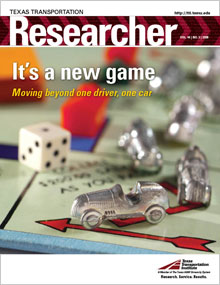
Even without record gas prices, the days of heavy dependence on “one driver, one car” are numbered.
Many can no longer afford the luxury. Across much of the state, there are simply too many people, with too many vehicles, attempting to go too many places at the same time. The resulting congestion is only one of the problems that result—there are also air-quality issues and safety concerns that must be addressed. And traffic demand is growing every day.
Fortunately, there are alternatives to the one driver, one car scenario.
As you will discover in this issue, TTI researchers are exploring innovative ways to help reduce congestion, improve safety and expand our transportation options.
In Dallas, corridor management is being integrated into a comprehensive system designed to provide travelers with better, more immediate traffic information, encourage alternative modes of transportation, and actively manage traffic flow to keep lanes open and vehicles moving.
 In Houston and Dallas, the role of preferential treatment for carpools is being examined, particularly as it relates to managed lane facilities. The managed lane concept itself is being further refined. Researchers, for example, are exploring practical ways of using variable tolls to assure predictable travel times—giving travelers a choice when time is of the essence.
In Houston and Dallas, the role of preferential treatment for carpools is being examined, particularly as it relates to managed lane facilities. The managed lane concept itself is being further refined. Researchers, for example, are exploring practical ways of using variable tolls to assure predictable travel times—giving travelers a choice when time is of the essence.
TTI is assessing the feasibility of converting landfill gas to liquefied natural gas for use in trucks and buses in India—a promising alternative to the current over-reliance on petroleum-based fuels.
The social and economic impacts of light and commuter rail in metropolitan areas are the subject of intense interest and study, as is bicycle and pedestrian safety in areas where roadwork is underway.
Safety is also the focus of several studies related to areas surrounding schools. One such study focuses on traffic control in school zones; another seeks ways to reduce the number of motorists who pass school buses while students are boarding.
As diverse as these efforts are, they share a common goal—to find safer and more effective ways of meeting our transportation needs.
Practicality is central to all of these efforts. As gas prices increase and vehicles become more fuel efficient, traditional transportation funding mechanisms are proving inadequate to meet current and future needs. This problem is further compounded by spiraling construction costs affecting the transportation industry. That makes it more important than ever for research to focus on practical solutions that are also cost effective.
It’s a big challenge, but with help from research, we can meet it.
